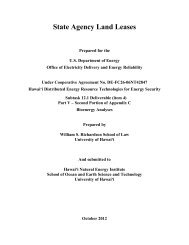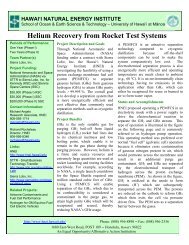Oahu Wind Integration Study - Hawaii Natural Energy Institute ...
Oahu Wind Integration Study - Hawaii Natural Energy Institute ...
Oahu Wind Integration Study - Hawaii Natural Energy Institute ...
Create successful ePaper yourself
Turn your PDF publications into a flip-book with our unique Google optimized e-Paper software.
advanced capabilities can contribute towards on-line reserve requirements and potentially<br />
increase total wind energy that can be accepted by the system.<br />
This study did not perform extensive analysis on strategies to mitigate variability that utilize<br />
energy storage because of constraints on the study's resources and timeline. While energy<br />
storage can be used to help mitigate the variability and uncertainty of wind power in the HECO<br />
system, the cost and benefit of energy storage would need to be explicitly compared against<br />
alternate technologies and strategies that were considered in this study. This type of comparative<br />
benefit-cost analysis was beyond the scope of the current study.<br />
Under the scenarios considered in this study, the team did conclude that energy storage is not<br />
necessary to manage the variability of the wind plants if the present ramp rate capabilities of the<br />
HECO thermal units are increased to the ramp rates proposed by HECO. This conclusion is<br />
sensitive to the underlying assumptions in the scenarios analyzed in the study. Each of the<br />
scenarios consists of a specific generation mix, wind plant sizes and locations, and assumed<br />
performance capabilities of the <strong>Energy</strong> Management System, thermal units, and wind plants. As<br />
the <strong>Oahu</strong> power system evolves, it may be necessary for HECO to reconsider the strategies and<br />
technologies to enable high levels of wind power, and/or consider alternate strategies to help<br />
enable the levels of wind power considered in this study.<br />
1.8. Recommendations<br />
This study shows that it is operationally feasible for the <strong>Oahu</strong> system to accommodate the wind<br />
projects and supply more than 25% of the island’s energy from the 500 MW of wind power and<br />
100 MW of solar PV projects, if the following strategies are incorporated:<br />
1.8.1. Operating Strategies<br />
• Incorporate state-of-the-art wind power forecasting into the unit commitment process and<br />
account for the availability of wind plants in this forecast,<br />
• Increase the up-reserve requirement to help manage sub-hourly wind variability and<br />
uncertainty in wind power forecasts,<br />
• Continuously monitor wind power variability and wind power forecast accuracy to<br />
improve above estimates and operating strategies,<br />
• Implement severe weather monitoring to ensure adequate unit commitment during<br />
periods of higher wind power variability,<br />
• Evaluate the effectiveness of including other resources capable of contributing to upreserve,<br />
such as fast-starting thermal units and load control programs,<br />
• Continuously monitor and report fast-start capacity and load control available to enhance<br />
real-time system operation during wind variability, wind uncertainty, and other events,<br />
• Implement a down-reserve requirement based on feasible loss-of-load events and the<br />
anticipated system response to the event,<br />
• Once the wind plants are in operation, further refine the down-reserve requirement based<br />
on actual wind plant over-frequency performance during loss-of-load events,<br />
• Integrate wind power measurements, automatic wind curtailment, and wind curtailment<br />
allocation in system operating practices.<br />
26




